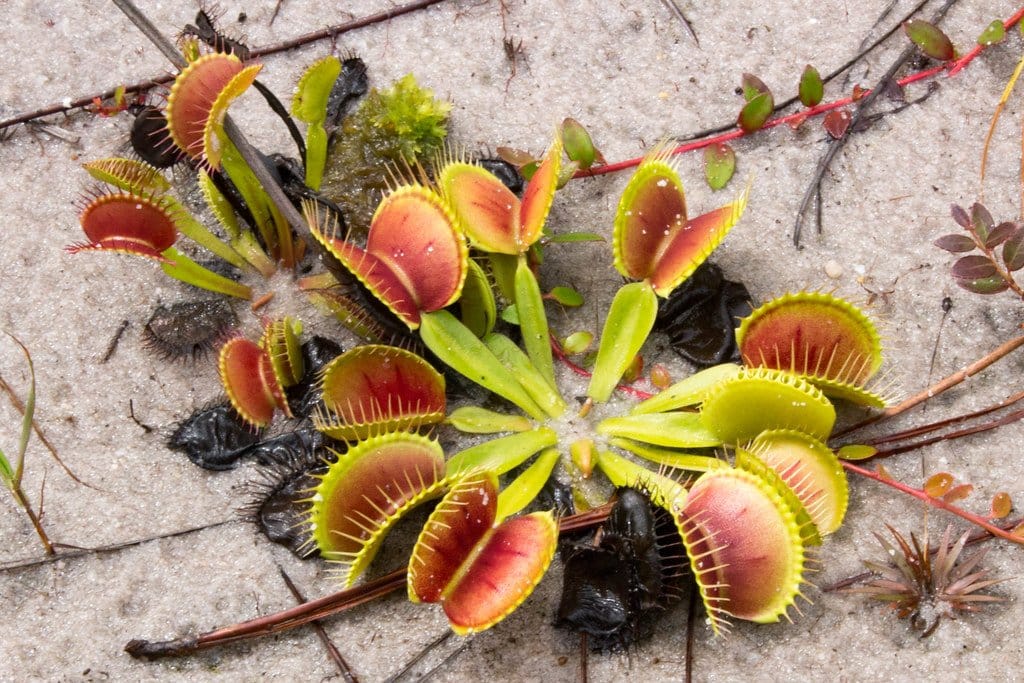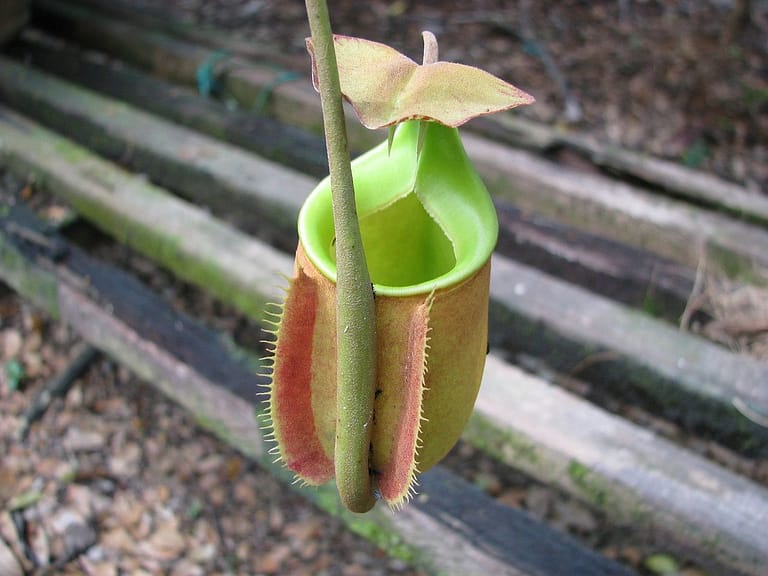Carnivorous plants, a fascinating and diverse group, have evolved unique adaptations to thrive in nutrient-poor environments. These plants have developed various mechanisms to trap and digest prey, primarily insects, to supplement their nutrient intake. This article explores the intriguing world of carnivorous plants, highlighting their distinct characteristics and survival strategies.
Venus Flytrap (Dionaea muscipula)

The Venus Flytrap is an iconic carnivorous plant native to subtropical wetlands on the East Coast of the United States. It’s most renowned for its distinctive trap mechanism. The plant’s leaves are bifurcated into two lobes that form a trap, which can snap shut in a fraction of a second when prey touches tiny hair-like structures inside. These sensitive hairs must be touched twice in rapid succession to trigger the trap, a clever adaptation that prevents the plant from wasting energy on non-nutritive stimuli. Once an insect is captured, the Venus Flytrap secretes digestive enzymes to break down its prey. The traps are primarily green with red inner surfaces, adding to their allure. This fascinating plant has become a symbol of carnivorous plants worldwide, intriguing scientists and plant enthusiasts alike with its complex predatory behavior.
Pitcher Plant (Nepenthes species)

The genus Nepenthes, commonly known as Pitcher Plants, consists of over 170 species, primarily found in Southeast Asia, Madagascar, and Australia. These plants are characterized by their remarkable pitcher-shaped leaves, which are actually modified leaf tips. These pitchers act as pitfall traps, luring prey with nectar, vibrant colors, and enticing scents. The inside of the pitchers is slippery and contains digestive fluids, ensuring that insects and even small vertebrates like frogs and rodents that slip inside cannot escape. The size, shape, and coloration of the pitchers vary widely among species, making each one unique. Some species, like Nepenthes rajah, have pitchers large enough to trap small mammals. These plants play a crucial role in their ecosystems and are subjects of extensive research due to their diverse ecological adaptations and varying prey-catching strategies.
Sundew (Drosera species)

Sundews, belonging to the genus Drosera, are mesmerizing carnivorous plants with over 190 species distributed globally. Known for their stunning dew-like glandular hairs, sundews capture prey using these sticky tentacles. The leaves of sundews are often brightly colored and covered in tiny hairs that secrete a sticky, sweet-smelling mucilage, resembling morning dew. When an insect becomes ensnared, the surrounding tentacles slowly curl around the prey, enhancing the trap and facilitating digestion. The plant then secretes enzymes to break down the insect, absorbing essential nutrients. Sundews thrive in nutrient-poor soils, compensating for the lack of nitrogen and phosphorus by digesting insects. Their ability to move their tentacles makes them one of the few carnivorous plants with noticeable motion, adding to their appeal. Sundews vary greatly in size, form, and habitat, with some species adapted to life in water and others in arid conditions.
Butterwort (Pinguicula species)

Butterworts are a fascinating group of carnivorous plants, with around 80 species primarily found in the Americas, Europe, and Asia. These plants exhibit a passive trapping mechanism using their flat, sticky leaves. The leaves are usually bright green or purple and coated with a shiny, glandular secretion that attracts and traps small insects. Once an insect is caught, the edges of the leaf slowly curl upwards, securing the prey. Butterworts produce enzymes to digest their victims, absorbing nutrients to supplement their growth in nutrient-poor environments. In addition to their carnivorous traits, Butterworts are known for their beautiful flowers, which resemble those of violets. They often inhabit wet, rocky areas, and some species are epiphytic, living on other plants. The dual nature of Butterworts, combining deadly traps with delicate flowers, makes them particularly intriguing among carnivorous plants.
Bladderwort (Utricularia species)

Bladderworts, encompassing over 230 species in the genus Utricularia, are among the most remarkable carnivorous plants due to their underwater suction traps. These plants can be found in fresh water and wet soil environments across the globe. Bladderworts lack roots and instead have finely divided, feathery leaves and small bladders, which are the key to their carnivorous lifestyle. These bladders function as traps, creating a vacuum inside. When tiny aquatic organisms touch the trigger hairs near the bladder opening, the trapdoor opens, swiftly sucking the prey inside. The process is so rapid that it’s considered one of the fastest movements in the plant kingdom. After the prey is trapped, digestive enzymes break it down, allowing the plant to absorb nutrients. Bladderworts are not only fascinating for their unique trapping mechanism but also for their beautiful, often orchid-like flowers that bloom above water, contrasting with their lethal submerged traps.
Cobra Lily (Darlingtonia californica)

The Cobra Lily, native to Northern California and Oregon, is a visually striking and unusual carnivorous plant. It’s named for its hooded leaves that bear a resemblance to a cobra’s head, complete with a forked leaf resembling a snake’s tongue. This plant traps insects using a combination of light and color. Transparent areas on the hood confuse prey, making them think there is a way out, while the plant’s slippery walls and downward-pointing hairs prevent escape. Once trapped, the insects are eventually digested by enzymes at the base of the tube. The Cobra Lily is unique among pitcher plants because it does not rely on a pool of water for digestion but rather produces its own digestive juices. It thrives in cold, nutrient-poor, and water-logged environments, making it a fascinating example of adaptation.
Australian Pitcher Plant (Cephalotus follicularis)

This small yet fascinating carnivorous plant is native to a limited region in Southwest Australia. The Australian Pitcher Plant, Cephalotus follicularis, has evolved pitcher-like traps to capture insects. Its pitchers are small, typically only a few centimeters tall, but they are highly effective at trapping prey. The outer surface of the pitchers is textured and may aid in camouflaging the plant among the moss and rocks of its habitat. The inner surface is slippery and contains digestive enzymes to break down captured insects. This plant is unique because it’s the only species in its genus, making it of particular interest to botanists and plant enthusiasts. Despite its carnivorous nature, Cephalotus also performs photosynthesis and can survive without consuming insects, though the additional nutrients aid its growth in nutrient-poor soil.
Waterwheel Plant (Aldrovanda vesiculosa)

The Waterwheel Plant is an aquatic carnivorous plant that captures prey with a mechanism similar to that of the Venus Flytrap. Found in still or slow-moving freshwater habitats across Europe, Asia, Africa, and Australia, Aldrovanda vesiculosa consists of floating stems with whorls of snap-traps along their length. Each trap, only a few millimeters in size, snaps shut in milliseconds when trigger hairs are stimulated, capturing small aquatic organisms. This plant is rootless and obtains nutrients from its prey, allowing it to thrive in nutrient-poor waters. The Waterwheel Plant is remarkable for its rapid trap movement and for being one of the few carnivorous plants to live entirely underwater. Due to habitat loss and water pollution, it’s considered a vulnerable species, making its conservation important.
Brocchinia Reducta

Brocchinia reducta is a unique carnivorous plant native to the tepuis of South America. It’s part of the Bromeliaceae family, which makes it quite distinct from other carnivorous plants. This species has evolved to trap insects in a water-filled tank formed by its tightly overlapping leaves. The inner walls of the leaves are slippery and coated with a waxy substance, causing insects to fall into the water at the base of the plant. Once trapped, the insects are digested by enzymes and bacteria, providing the plant with essential nutrients. Brocchinia reducta is an example of a plant adapting carnivorous traits independently, showcasing the diverse evolutionary paths to carnivory in plants. Its adaptation to nutrient-poor environments is a remarkable demonstration of nature’s ingenuity.
Heliamphora (Sun Pitcher Plant)

Heliamphora, or Sun Pitcher Plants, are native to South America, particularly the Guiana Highlands. These plants are characterized by their elongated, tubular pitchers, which are modified leaves designed to trap insects. The pitchers fill with rainwater, and insects attracted by nectar around the rim lose their footing on the slippery surface and fall into the water. Once inside, they are unable to escape due to the pitcher’s downward-facing hairs and eventually drown. The plant then absorbs nutrients from the decomposing insects. Heliamphora pitchers are often adorned with a spoon-shaped appendage above the opening, which may help in attracting prey or protecting the pitcher’s contents from excess rainwater. These plants grow in nutrient-poor, acidic soils, and their carnivorous nature is an adaptation to these challenging environmental conditions.
Byblis (Rainbow Plant)

The Rainbow Plant, or Byblis, is a genus of carnivorous plants known for their striking appearance and sticky, insect-trapping leaves. Native to Australia and New Guinea, these plants have slender, elongated leaves covered with glandular hairs that secrete a sticky, mucilaginous substance. This secretion glistens in the sunlight, creating a rainbow-like effect, hence the name. Insects attracted to the sticky droplets become ensnared, and the plant then secretes enzymes to digest the trapped prey. Byblis is often mistaken for a sundew, but it differs in its method of prey digestion and flower structure. The plant’s flowers are typically small and delicate, adding to its ornamental appeal. Byblis grows in nutrient-poor, sandy soils, and its carnivorous habit helps it obtain essential nutrients, particularly nitrogen and phosphorus, from its prey.

